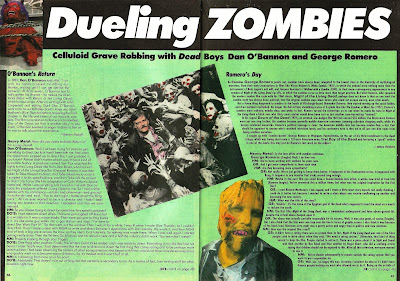Timespirits
Steve Perry (writer) and Tom Yeates (art)
Cat Yronwode, Sam Parsons, Tom Yeates, Steve Oliff (colors)
Gaspar Saladino, Janice Chiang, Ed King (letters)
Epic / Marvel, October 1984 - March 1986
In 1979 the English author Douglas Adams published his first book, The Hitchhiker's Guide to the Galaxy, which was based on a comedy series he had produced on BBC radio starting in 1978. At the time of Adams's death in 2001 (at the age of 49), the series consisted of five volumes, all of which had become international best-sellers.
The Hitchhiker's Guide and its sequels took a free-form approach to sf humor, taking well-known tropes in the genre and tossing them altogether into one giant mix of 'absurdist' storytelling.
Previous to Hitchhiker, full-time sf writers had tried to write humorous sf in an absurdist vein, particularly during the New Wave era. These dedicated sf writers included Philip Jose Farmer, R. A. Lafferty, and Ron Goulart, who wrote a slew of DAW Books all centered on humor. For various reasons, these efforts never progressed much beyond fostering a small, sub-sub genre of sf.
Perhaps it was a case of being in the right time, and the right place, but Hitchhiker - and its considerable success financially and critically - was the inspiration for the quick emergence of all sorts of 'humorous sf' novels, short stories, comics, and movies in the 1980s.
Arguably the most influential of the works inspired by Hitchhiker was Terry Pratchett's The Colour of Magic (1983), the initial volume in what would become the publishing juggernaut of 'Discworld'.
...............which brings us to Timespirits.
The 8-issue miniseries was released by Epic / Marvel bimonthly from October 1984 - March 1986.
In the first issue, set in Maine in 1633, we are introduced to Doot, a young Indian boy of the Wawenock tribe. Doot's older brother, King Freddie Three Birds, has embarked on a campaign of resistance to the English settlers streaming into Wawenock territory. During a violent encounter with the palefaces, Doot is saved from death by a mysterious apparition: an elderly Indian man wearing a fedora, and toting an array of artifacts and gadgets recovered from all over time and space.
This elderly man is named Cusick, from the Tuscarora tribe. Cusick is a Timespirit, a shaman gifted with the ability to instantaneously travel through time and space, to strange worlds that exist in alternate realities.
Writer Steve Perry patently models Cusick on Carlos Cataneda's Don Juan Matus, save that Cusick is much more expressive, continually delivering aphorisms and bits of Native American Wisdom disguised as one-offs and wisecracks.
Cusick recognizes that Doot is in fact an innate Timespirit, and recruits him to a life of travelling the time streams. As issue one concludes, the two embark on what will be an array of wild adventures.
I won't disclose any spoilers, but over the course of the eight issues, Doot and Cusack encounter bumbling wizards; a vampire; dinosaurs; Custer; Yeti; Jim Hendrix; and a blue-skinned cat girl named 'Thornypaws' who wears only a g-string, and is likely the inspiration for the aliens in the James Cameron film Avatar.......
Steve Perry's narrative sticks pretty closely to the humor-centered attitude of the Douglas Adams / Terry Pratchett genre, although there are rather incongruous scenes of violence and bloodshed that pop up every now and then and presumably, keep things from getting too hokey.
Some installments of Timespirits rather awkwardly stray from the 'madcap' humor approach; for eample, issue 5 adopts an overwrought exposition about how Rock and Roll, and its rebellious qualities, is all that stands between the relentless corporatization of society.....
I am definitely not a fan of humorous sf nor the Adams and Pratchett novels. But what made me pick up Timespirits was the exemplary artwork by Tom Yeates, who continues to be one of the best draftsmen in comics.
The colors, primarily done by Steve Oliff, are serviceable, no mean feat since it was likely that Timespirits was printed - like many other 80s comics - on a flexographic press. The flaws of this process are too noticeable to be overlooked - Doot and Cusack frequently have dark gray skintones - but it's not Oliff's fault.
Summing up, if you're a fan of humorous sf, and particularly the style of Douglas Adams and Terry Pratchett, then Timespirits will appeal to you. Even if you're not a fan of the humorous sf subgenre, if you appreciate fine graphic art and illustration, then the series also may be worth acquiring. Entire sets of all eight issues can be had for reasonable prices from your usual dealers.











































































